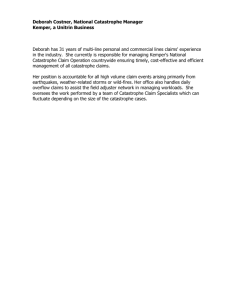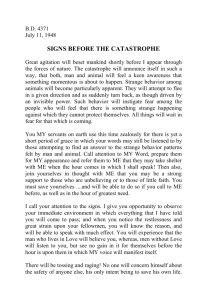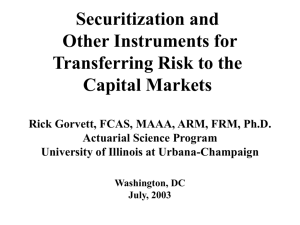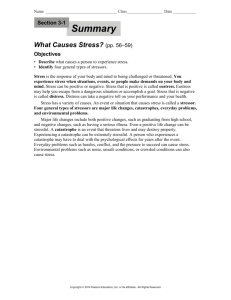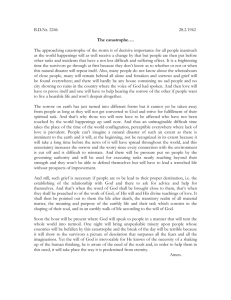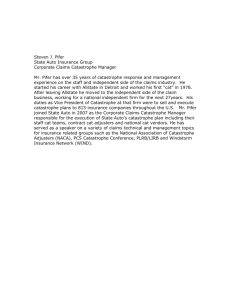securitization 101 - University of Illinois at Urbana
advertisement
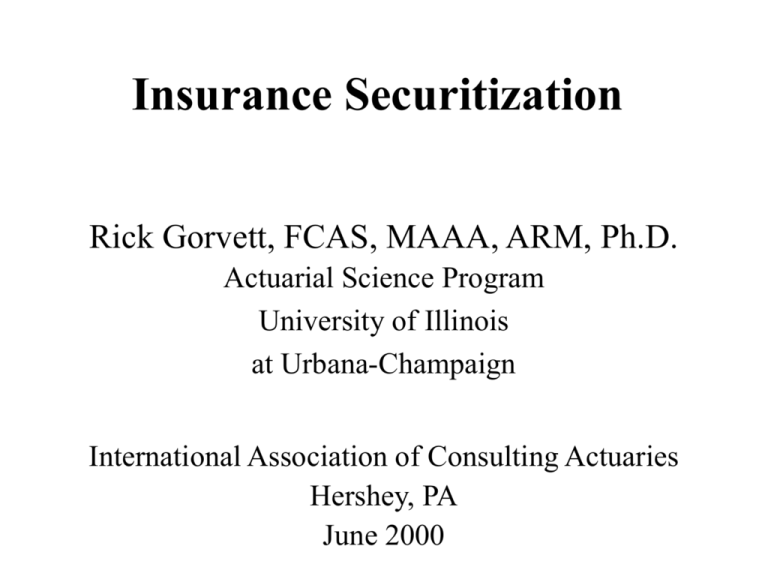
Insurance Securitization Rick Gorvett, FCAS, MAAA, ARM, Ph.D. Actuarial Science Program University of Illinois at Urbana-Champaign International Association of Consulting Actuaries Hershey, PA June 2000 Risk and Response • Risk – Recent catastrophes – Resulting insolvencies and financial impairment – Potential for even greater impact • Response – Development of securitized insurance products What is “Securitization of Insurance Risk”? • Insurance company transfers underwriting risks to the capital markets by transforming underwriting cash flows into tradable financial securities • Cash flows (e.g., repayment of interest and/or principal) are contingent upon an insurance event / risk Securitization in Historical Perspective • Home mortgage market: funding shortfall in the late 1970s • Market response: mortgage-backed securities • Other asset-backed securities developed subsequently – Auto loans – Credit card receivables – David Bowie albums Securitization Process • Participants – – – – – Borrower Loan originator Special purpose trust Underwriter Investors • Some of the Benefits – – – – Liquidity Market values Lower cost Improved credit rating Evolution of the Insurance Industry “Affronts” to Traditional Insurance • Self-insurance and captives • Risk retention groups • Insurance securitization • Portfolio insurance Risks Which P/C Insurers Face • Underwriting – – – – – Loss experience: frequency and severity Underwriting cycle Inflation Payout patterns Catastrophes • Investment – Interest rate risk – Capital market performance All of these risks can prevent a company from meeting its objectives Insurance Securitization in Context: Managing Risks • Insurance securitization is one of many financial risk management (FRM) techniques • Building blocks of FRM: – – – – Stocks and bonds Forwards and futures Options Swaps Factors Affecting the Recent Development of Insurance Securitization • Recent catastrophe experience – Reassessment of catastrophe risk – Demand for and pricing of reinsurance – Reinsurance supply issues • Capital market developments – Development of new asset classes and assetbacked markets – Search for yield and diversification • Restructuring of insurance industry Possible Reasons for Securitizing Insurance Risks • Capacity – Risk of huge catastrophe losses – Would severely impair P/C industry capital – Capital markets could handle • Investment – Catastrophe exposure is uncorrelated with overall capital markets – Thus, uncorrelated with existing portfolios – Diversification potential Issues Regarding the Potential Success of Insurance Securitization • Difficult to understand – Capital markets – Insurance markets • Separation of insurance and finance functions in many companies • Information and technology • Difficult to price • Expensive (vs. cat. reinsurance market) • Legal / tax / accounting issues Types of Insurance Instruments • Those that transfer risk – – – – Reinsurance Exchange-traded derivatives Swaps Catastrophe bonds • Those that provide contingent capital – Letter of credit – Contingent surplus notes – Catastrophe equity puts Exchange-Traded Derivatives • Chicago Board of Trade – Option spreads ~ reinsurance – PCS: daily index values – Nine geographic products • Bermuda Commodities Exchange – Binary options – Guy Carpenter Catastrophe Index – Seven geographic products Risk Exchanges and Swaps • CATEX New York – Electronic bulletin board – Catastrophe exposure swaps • CATEX Bermuda – Joint venture: CATEX and Bermuda Stock Exchange • Swaps Catastrophe Bonds: The Trigger Issue • Basis risk – How closely do the company’s losses follow the industry index? • Moral hazard – Increased losses to company may decrease the debt obligations Trade-off between basis risk and moral hazard Direct versus industry versus event triggers Types of Bond Triggers • Direct: based on company losses – E.g., USAA catastrophe bond – No basis risk • Industry: based on an index – E.g., Swiss Re; CBOT PCS option spreads – Essentially no moral hazard • Event – E.g., Tokio Marine & Fire – Earthquake magnitude Types of Catastrophe Bond Risk-Taking • Risk of losing some or all of your principal – Defeasement of principal with U.S. Treasuries? • Risk of diminished or lost interest payments • Often, several “tranches” with different yields and ratings Typical Catastrophe Bond Issuance Structure • Insurance company sets up an SPV (Special Purpose Vehicle) -- offshore reinsurer • Company purchases reinsurance contract from SPV • Company issues bonds to capital markets through SPV Some Successful Bond Issues • USAA: company’s hurricane losses • Swiss Re: industry’s California E/Q losses • Tokio Marine & Fire: Tokyo E/Q magnitude • Centre Re: company’s Florida hurricane losses • Yasuda Fire & Marine: typhoon losses • Swiss Re: “basis swap” with reinsurer Generally Common Traits of Successful Bond Issues • Involve catastrophe risk • High levels of protection • Relatively short maturities • Some protection of principal included • High coupon rates “Costs” of Catastrophe Bonds • High yields – Default premiums may be high for a time • Setting up SPV • Investment banking fees – Advising – Spread • Legal fees Contingent Capital • Contingent surplus notes – Option to borrow, contingent upon some event or trigger – Right to issue surplus notes • Catastrophe equity puts – Put option (right to sell) – Right to issue shares of stock, contingent upon some event or trigger The Future of Insurance Securitization • Will it survive and grow? – Cost relative to insurance and reinsurance – Time and technology • Will it replace or supplement traditional transactions? • How will it affect reinsurance? The Future of Insurance Securitization (cont.) • Capacity versus other reasons • Catastrophe risks versus traditional insurance lines • Historically, markets for other forms of securitizations have taken some time to develop and mature The Future of Insurance Securitization (cont.) • Legal and tax issues – Are securitization instruments insurance? – Bermuda Insurance Amendment Act (1998): insurance derivatives are “investment contracts” – Different tax implications: • Protect income statement • Protect balance sheet The Future of Insurance Securitization (cont.) • Insurer FRM can take a variety of forms – Asset hedges • Reinsurance • Derivatives – Liability hedges • Debt forgiveness – Asset-liability management – Contingent financing – Post-loss financing and recapitalization Personal Info • Web page: http://www.math.uiuc.edu/~gorvett • E-mail: gorvett@uiuc.edu


